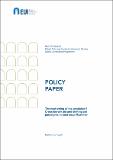Files in this item
The next swing of the pendulum? Cross-border aid and shifting aid paradigms in post-coup Myanmar
Item metadata
| dc.contributor.author | Fumagalli, Matteo | |
| dc.date.accessioned | 2022-07-21T16:30:07Z | |
| dc.date.available | 2022-07-21T16:30:07Z | |
| dc.date.issued | 2022-07-22 | |
| dc.identifier | 280534972 | |
| dc.identifier | 8d927073-b137-4528-8883-5fe20a85c028 | |
| dc.identifier.citation | Fumagalli , M 2022 ' The next swing of the pendulum? Cross-border aid and shifting aid paradigms in post-coup Myanmar ' European University Institute Robert Schuman Centre Policy Papers , no. 08 , vol. 2022 , European University Institute , Florence . < https://cadmus.eui.eu/handle/1814/74769 > | en |
| dc.identifier.issn | 1830-1541 | |
| dc.identifier.other | ORCID: /0000-0002-1451-2088/work/116274823 | |
| dc.identifier.uri | https://hdl.handle.net/10023/25690 | |
| dc.description | The research for this project was supported by the UK’s Arts and Humanities Research Council (grant reference AH/S00405X/1). | en |
| dc.description.abstract | The 1 February 2021 military coup in Myanmar confronted the international community, including donors and aid workers, with a significant challenge: how to ensure that relief and life-saving support are delivered to those in greatest need at a time when international attention – and already limited resources – are likely to come under severe stress in the aftermath of the Russian invasion of Ukraine in February 2022. From the early 2010s onwards, Myanmar had shed its status of international pariah (under western sanctions) to take on the ‘mantel’ of the ‘donors’ darling.’ This reflected an important rapid change from isolation to engagement in the way that many western (and some non-western) actors approached relations with the country. From the late 2000s onwards, international assistance moved from non-governmental organisations in the borderlands – also based in neighbouring countries – to the national government, and from humanitarian aid to development. In the aftermath of the coup the encounter between the international donor community and the people of Myanmar is likely to be re-defined by a triple shift in the aid paradigm putting earlier trends in reverse gear: from engagement to isolation, from development to humanitarian aid and from the state and government to non-state and informal institutions in the borderlands. With the military regime engaged in a de facto aid blockade, cross-border aid is likely to be the most realistic way to deliver humanitarian and emergency aid and relief to local communities, particularly in Myanmar’s border regions. The distribution and delivery of aid will be best served by close cooperation with local migrant-based community-building organisations and civil society groups, and cross-border charities and NGOs based in and around refugee camps, drawing on their networks and experience in delivering aid during previous rounds of refuge and displacement. | |
| dc.format.extent | 9 | |
| dc.format.extent | 464054 | |
| dc.language.iso | eng | |
| dc.publisher | European University Institute | |
| dc.relation.ispartofseries | European University Institute Robert Schuman Centre Policy Papers | en |
| dc.subject | Myanmar | en |
| dc.subject | Burma | en |
| dc.subject | Junta | en |
| dc.subject | Coup | en |
| dc.subject | Resistance | en |
| dc.subject | International community | en |
| dc.subject | Aid | en |
| dc.subject | Development assistance | en |
| dc.subject | Aid paradigm | en |
| dc.subject | Humanitarian aid | en |
| dc.subject | Cross-border aid | en |
| dc.subject | JZ International relations | en |
| dc.subject | SDG 16 - Peace, Justice and Strong Institutions | en |
| dc.subject.lcc | JZ | en |
| dc.title | The next swing of the pendulum? Cross-border aid and shifting aid paradigms in post-coup Myanmar | en |
| dc.type | Working or discussion paper | en |
| dc.contributor.institution | University of St Andrews. School of International Relations | en |
| dc.contributor.institution | University of St Andrews. Institute of Middle East, Central Asia and Caucasus Studies | en |
| dc.identifier.url | https://cadmus.eui.eu/handle/1814/74769 | en |
This item appears in the following Collection(s)
Items in the St Andrews Research Repository are protected by copyright, with all rights reserved, unless otherwise indicated.

